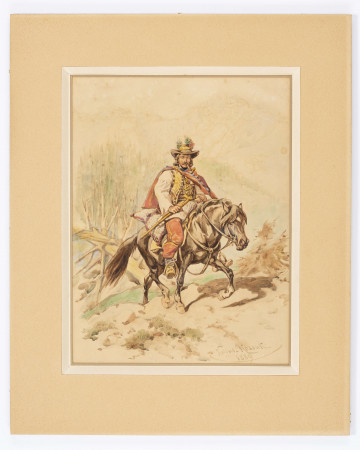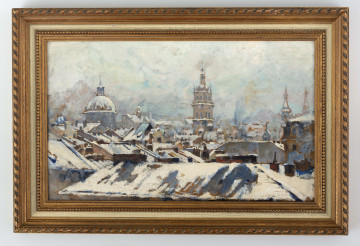
Autumn landscape
1896
National Museum in Lublin
Part of the collection: Polish landscape painting (19th–1st half of the 20th c.)
Landscape painting was an enduring genre in Józef Mehoffer's entire oeuvre, becoming a central area of reflection on the creative model of art. The artist wrote that ‘art has always processed and will always process nature, searching for style in it’. In his monumental art – the Wawel frescoes – he used plant motifs as stylised forms carrying the symbolic meaning of a mystical garden. Plant tendrils were also a compositional accent, filling in the background of portrait representations. The landscape of paradise became the setting for an intimate, personal imagery in the artist's best-known painting, the magical Dziwny ogród [Strange Garden], rich in complex meanings.
Communing with nature was an important part of the artist's life – he himself designed a terraced garden in Jankówka near Wieliczka (1907) surrounding an alcove manor house where he lived with his family until 1917. Later he managed a garden in the urban development of Krakow, where the museum-home of the artist is located until today. The designed gardens had an orderly and geometric shape and were filled with lush vegetation, becoming the subject of numerous compositions saturated with intense, bright colours, offering a mood of peace, serenity and harmony. The bucolic orchards, gardens and fields were also created during the painter's holiday stays at friends’ estates.
Pejzaż z wrzosami [Landscape with Heather] is a testimony to holiday encounters with lush nature, interpreted in a freer, ‘impressionistic’ style. A dirt road, obliquely leading between purple heather and overgrown yews, escapes into the depths of the painting, marking the direction of the trip, introducing the viewer to a free, lush landscape illuminated by the setting sun. The painterly play of intense colours is an extremely careful and thoughtful study of composition, based on the balance of opposites: colour contrasts and rhythmic shapes.
The landscape is an attempt to achieve compositional completeness by means of the alignment of colours which mark the route of the gaze's wandering around the painting. The painting is a praise of cheerful and harmonious life, at the same time the glow of the setting sun evokes reflection on the transience of human existence, recognised in the shapes of nature, alluding to the tradition of symbolism from the time of the artist's youthful work.
Author / creator
Dimensions
cały obiekt: height: 42 cm, width: 52 cm
Object type
painting
Technique
oil technique
Material
canvas, oil-based paint
Creation time / dating
Creation / finding place
Owner
The National Museum in Lublin
Identification number
Location / status

1896
National Museum in Lublin

1889
National Museum in Lublin

1923
National Museum in Lublin
DISCOVER this TOPIC
National Museum in Lublin
DISCOVER this PATH
Educational path